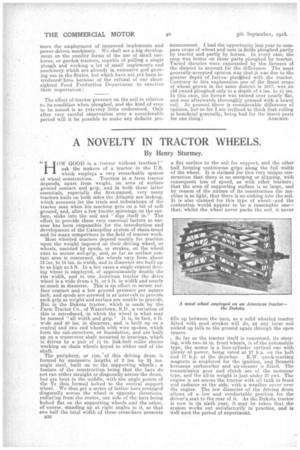AGRIMOTOR NOTES.
Page 17

Page 18

If you've noticed an error in this article please click here to report it so we can fix it.
Intensive and Extensive Farming. Britain as a Self-supporting Nation.
The Germans are evidently fully alive to the value of agricultural machinery to the community, if we may judge by the latest photograph illustrated of German " kultur " which comes from the Front. It shows a wide area outside a ruined French village on to which all the agricultural implements of the little . community have been brought and deliberately smashed. Ploughs, harrows, rollers, rakes; mowing machines and threshers lie about—or rather the parts of them do—in inextricable .confusion, showing the ruthless rage with which these self-styled " supermen" have done their puny best to destroy the possibility of the villagers again making themselves selfsupporting when if ever they come into their own again. The picture causes one to reflect as to where we should all be if all the farm implements in the country were destroyed: A further consideration of the theme brings heme more strongly than ever the value of the latest and most improved methods and machinery in agricultural work, and hence the great national value of the farm tractor, which is the greatest advance, that has yet been made in agricultural machinery, seeing that whereas all the other developments of the past century—the disc harrow, the drill, the mower, the reaper and binder, the threshing machine, etc., etc.--have effected economies in regard to human labour and made it more efficient, the tractor is the first to economize horse labour as well and render it possible for deeper tillage to be effected. Slow as our people have been in pm-war times to recognize the value, and avail themselves of the use of these machines, those of us who have had the opportunity of personal observation of farmers and their methods over the last half century will recall that the early reception of all these aids to agriculture which are now in universal use has been equally, if not more, slow and tentative.
American farmers have taken up tractor employment for the purpose of extensive farming as, by its use, they have been enabled to cultivate larger acreages, and it is an established fact, vouched for by the U.S. Government Bureau, that a very high proportion of those farmers there who have adopted tractors, have substantially increased the size of their holdings after doing so. European development, as exemplified particularly in France and Belgium, has tended in.the opposite direction, i.e., in the direction of intensive farming, under which system larger areas are not dealt with, but the production of the acreages of small farms increased, and in old and fully settled countries such as these, where larger areas are not to be had, this undoubtedly is a most valuable development. There is, however, not necessarily any antagonism in the two methods, and the tractor can be made as useful in the one direction as in the other. Intensive culture, as we know it here, involves a large amount of personal or hand work, but the tractor, by doing work easier and in a shorter time, is an mono mizer of labour of the greatest value as, by doing all this heavier work and doing it quickly, the available labour is released for the more intensive work which can at present only be done by hand. Ai time goes on, no doubt, development will take place in tractor drawn implements which will enable power-propelled machinery to be used more and more for intensive work, and so, in a little and limited country such as ours, the largest amount of produce possible will be secured from the available land.
If the entire acreage of available agricultural-land were cultivated intensively to the same effect, as regards crop results, as is seen on the small Breton farms and on our own most advanced market gardens, there would be no longer any doubt about the land of this country being able to support the entire population without outside assistance, and that is the direction in which British farming should move. Extensive intensive farming, if I may so term it, should and will be the farming of the future, involving more and more the employment of improved implements and power-driven machinery. We shall see a big development on the smaller farms of the use of Small onehorse, or garden tractors, capable of pulling a single plough and working a lot of small implements and machinery which are already in extensive arid growing use in the States, but which have not yet been introducedthere because of the refusal of our shortsighted Food Production Department. to sanction their importation!
The effect of tractor pressure on the soil in relation to its condition when ploughed, and the kind of crop to be raised is as yetavery little understood. Only after very careful observation over a considerable period will it be possible to make any definite pro
nouncement. I had the opportunity last year to compare crops of wheat and oats in fields ploughed partly by tractor and partly by horses. In every case, the crop was better on those parts ploughed by tractor. Varied theories were expounded by the farmers of the district to account for the difference. The most generally-accepted opinion was that it was due to the greater depth of furrow plodglied with the tractor. Contrary to this explanation one of the finest crops of wheat grown in the same district in 1917, was an old sward ploughed only to a depth of 4 ins. to 4k ins, In this case, the furrow was turned over nearly flat, and was afterwards thoroughly pressed with a heavy roll. At present there is considerable difference of opinion, but so far I am inclined to think that rolling is beneficial generally, being bad for the insect pests
for one thing I AGRIVIOT.






















